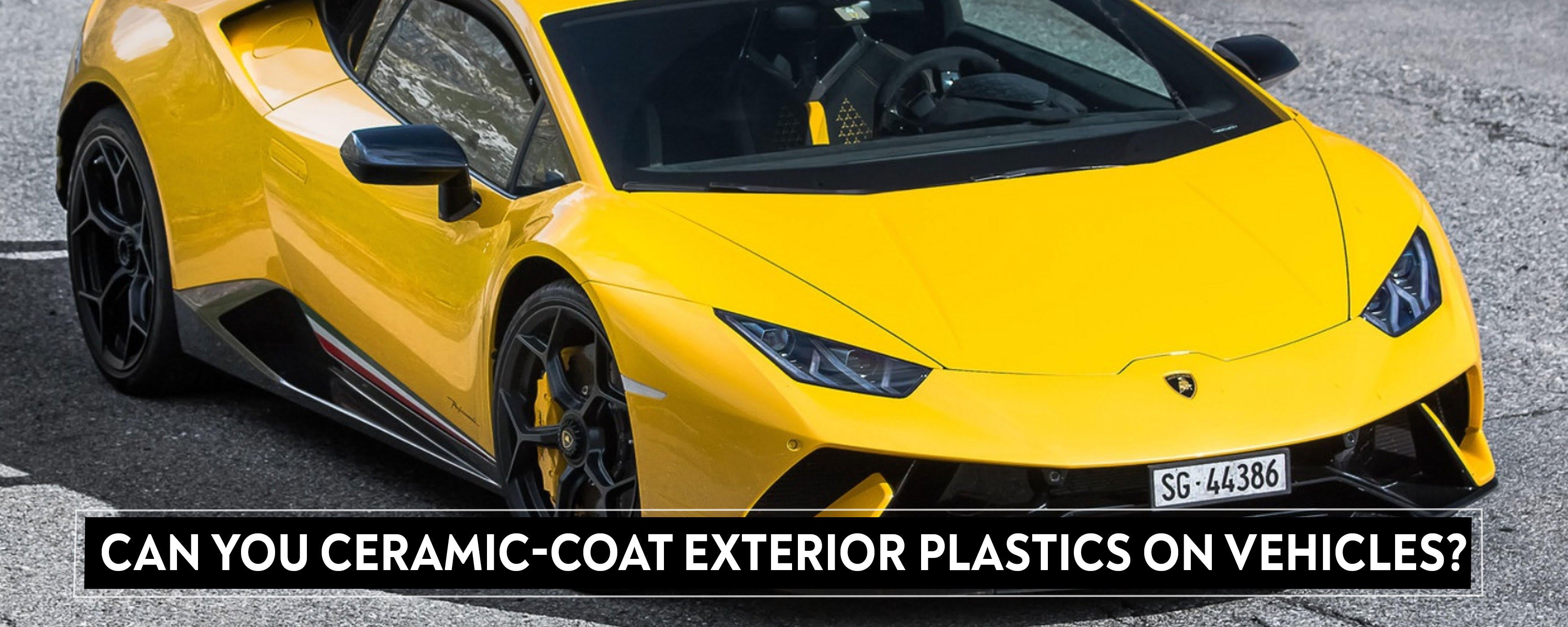
FREE US SHIPPING ON ORDERS $75+ (LOWER 48 STATES)
FREE DETAILING ADVICE +1-877-838-2672


In just the past few years, ceramic coating has become a popularized method of protecting the paint on a vehicle from the elements. Ceramic coating is a process that adds a bonding product that hardens after application where it will then become hydrophobic to repel water, dust, dirt, and other elements. Consequently, keeping a vehicle clean longer. However, there has been much confusion over ceramic coating and what you can apply it to, including the exterior plastic on cars, trucks, SUVs, RVs, and even off-roading vehicles.
To simply answer if you can ceramic coat the exterior plastics on vehicles you will have to look at the type of ceramic coating that you are using. In a nutshell, yes, you can ceramic coat the exterior plastic of a car, truck, SUV, RV, or ATV – but only some ceramic coatings are best for plastic exterior application.
Ceramic coatings are the first line of defense in preventing elements from sticking to the paint on your vehicle. They are effective for resisting water and other elements in preventing them from sticking to treated surfaces. However, some ceramic coatings will clearly state that they are not to be applied to anything other than your paint finish, which will exclude the application on exterior plastics. There are some ceramic coatings that are effective for application to exterior plastics, such as TopCoat® Crystaleen®.
Products like TopCoat® Crystaleen® can be applied to exterior plastics and effectively protect them because of many unique factors. The first factor is that TopCoat® Crystaleen® has a 7H hardness, which allows the product to flex. This factor is one where other ceramics may tout a 9H hardness and will eventually fail when applied to vehicle exterior plastics. The reason for the failure is because exterior plastics on vehicles tend to flex often and may result in inferior ceramics that claim to have a 9H hardness to flake off or chip away. Having a ceramic like TopCoat® Crystaleen® will allow the application to flex with the plastics thus remaining in place to protect the plastic surface for many years to come.
Another aspect of TopCoat® Crystaleen® that allows it to be applied to exterior plastics of vehicles is it adheres to surfaces like clearcoat paint and plastics by chemical and mechanical bonding. As a permanent coating that bonds molecularly to the surface, TopCoat® Crystaleen® has long-lasting protection benefits that are shared with application to painted surfaces. There’s virtually no difference in the effectiveness of applying TopCoat® Crystaleen® to painted surfaces versus exterior plastic surfaces. Such types of bonding allow TopCoat® Crystaleen® to bond to other surfaces like Paint Protection Films (PPF). Yes, TopCoat® Crystaleen® can also be safely applied to PPF on vehicles.
The application of TopCoat® Crystaleen® is simple, too. All you do to apply TopCoat® Crystaleen® to exterior vehicle plastics is to ensure all the surfaces are clean and dry and out of direct sunlight. It may help to use 91% rubbing alcohol on the plastic before coating to ensure it is cleaned of any containments and dry to the touch. Spray on a thin layer Stage 1 in fan-like motions in addition to spraying a clean and dry TopCoat applicator pad until it is saturated but not dripping. Wipe it on the plastic surface. Then, immediately spray Stage 2 over the same area that you applied Stage 1. Let it stand for about 15 seconds before buffing. Lastly, buff the surface with a clean and dry TopCoat® microfiber towel. Repeat the process until all of the plastic areas are done.
Pro Tip: For improved shine, durability, and protection, apply multiple layers of TopCoat® Crystaleen® as it is one of the only ceramic coatings that can layer. Additionally, TopCoat® F11PRO® is a functional ceramic that may be used on all vehicle exterior plastics, in addition to interior plastics.
Many ceramic coatings will make outlandish claims of having 9H hardness or ridiculous bonding agents so it will “stick” to a surface and remain there for many years to come. Most of those ceramic coatings do not have the proper bonding agents or durability to be applied to exterior plastics on vehicles and may cause damage to the plastic. Basically, some ceramic coatings are one-trick ponies meaning that they can only be applied to painted surfaces. Applying some ceramic coatings to exterior plastics could result in damages or a mess that requires removal by a professional costing hundreds to thousands of dollars.

We want you to be 100% satisfied with everything you buy from TopCoat. And if you’re not entirely happy with your purchase we will refund your money in full, or exchange the goods. All we ask is that you contact our customer services and then return the products back to us.